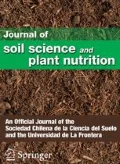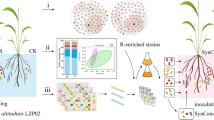Abstract
The use of termite mound soils in enhancing soil fertility and plant growth, especially in areas with poor soil conditions, has been recommended by many research studies. Most of these recommendations are, however, based on the high nutrient levels in termite mound soils. Thus, this study aimed to verify if plant growth–promoting bacteria in termite soils also play a role in improving plant growth. To achieve our purpose, we made an effort in characterizing the bacterial genes contributing to plant-beneficial function in termite mound soils with the shotgun metagenomics method. Results from this study revealed the presence of bacterial genes involved in the production of siderophores, acetoin, trehalose, phenazine, butanediol, 4-hydroxybenzoate, chitinase, 1-aminocyclopropane-1-carboxylate (ACC) deaminase, quorum sensing molecules, and mineral phosphate solubilization. In addition, we identified bacterial genes involved in the manufacturing of catalases, peroxidases, and superoxide dismutases that confer resistance to oxidative stresses in plants. Bacterial genes responsible for glycine-betaine production and cold and heat shock tolerance which helps in withstanding abiotic stress, were also present. With these plant growth–promoting traits observed in bacteria from termite mound soils, we recommend the isolation and the use of termite mound soil bacteria both in greenhouse and field trials to further ascertain their potential in improving soil fertility and crop production.






Similar content being viewed by others
References
Ahemad M, Kibret M (2014) Mechanisms and applications of plant growth promoting rhizobacteria: current perspective. J King Saud University Sci 26:1–20
Ali IG, Sheridan G, French J (2013) Ecological benefits of termite soil interaction and microbial symbiosis in the soil ecosystem. J Earth Sci Geotech Engr 3:63–85
Andreeva IG, Golubeva LI, Kuvaeva TM, Gak ER, Katashkina JI, Mashko SV (2011) Identification of Pantoea ananatis gene encoding membrane pyrroloquinoline quinone (PQQ)-dependent glucose dehydrogenase and pqqABCDEF operon essential for PQQ biosynthesis. FEMS Microbiol Lett 318:55–60
Audrain B, Ghigo J-M, Farag MA, Ryu C-M (2015) Role of bacterial volatile compounds in bacterial biology. FEMS Microbiol Rev 39:222–233
Aydin M, Tombuloglu G, Sakcali MS, Hakeem KR, Tombuloglu H (2019) Boron alleviates drought stress by enhancing gene expression and antioxidant enzyme activity. J Soil Sci Plant Nutr 19:545–555
Babalola OO (2010) Beneficial bacteria of agricultural importance. Biotechnol Lett 32:1559–1570
Bama PS, Ravindran AD (2018) Influence of combined termite mound materials and inorganic fertilizers on growth parameters of maize under non sterilized pot culture study. Elixir Appl Zool:52303–52305
Bashan Y, De-Bashan LE (2010) How the plant growth-promoting bacterium Azospirillum promotes plant growth—a critical assessment. Adv Agron 108:77–136
Batalha L, Da Silva FD, Martius C (1995) Using termite nests as a source of organic matter in agrosilvicultural production systems in Amazonia. Sci Agric 52:318–325
Belbahri L, Chenari Bouket A, Rekik I et al (2017) Comparative genomics of Bacillus amyloliquefaciens strains reveals a core genome with traits for habitat adaptation and a secondary metabolites rich accessory genome. Front Microbiol 8:1438
Bloemberg GV, Lugtenberg BJJ (2001) Molecular basis of plant growth promotion and biocontrol by rhizobacteria. Curr Opin Plant Biol 4:343–350
Bruto M, Prigent-Combaret C, Muller D, Moënne-Loccoz Y (2014) Analysis of genes contributing to plant-beneficial functions in plant growth-promoting rhizobacteria and related Proteobacteria. Sci Report 4:6261–6261
Chakdar H, Dastager SG, Khire JM, Rane D, Dharne MS (2018) Characterization of mineral phosphate solubilizing and plant growth promoting bacteria from termite soil of arid region. Biotech Histochem 8:463
Chauhan AK, Maheshwari DK, Kim K, Bajpai VK (2016) Termitarium-inhabiting Bacillus endophyticus TSH42 and Bacillus cereus TSH77 colonizing Curcuma longa L.: isolation, characterization, and evaluation of their biocontrol and plant-growth-promoting activities. Can J Microbiol 62:880–892
Chauhan AK, Maheshwari DK, Dheeman S, Bajpai VK (2017) Termitarium-inhabiting Bacillus spp. enhanced plant growth and bioactive component in turmeric (Curcuma longa L.). Curr Microbiol 74:184–192
Cheik S, Bottinelli N, Soudan B et al (2019) Effects of termite foraging activity on topsoil physical properties and water infiltration in Vertisol. Appl Soil Ecol 133:132–137
Choi O, Kim J, Kim J-G, Jeong Y, Moon JS, Park CS, Hwang I (2008) Pyrroloquinoline quinone is a plant growth promotion factor produced by Pseudomonas fluorescens B16. Plant Physiol 146:657–668
Cobo-Díaz JF, Fernández-González AJ, Villadas PJ, Robles AB, Toro N, Fernández-López M (2015) Metagenomic assessment of the potential microbial nitrogen pathways in the rhizosphere of a Mediterranean forest after a wildfire. Microb Ecol 69:895–904
Deke AL, Adugna WT, Fite AT (2016) Soil physic-chemical properties in termite mounds and adjacent control soil in Miyo and Yabello Districts of Borana Zone, Southern Ethiopia. Amer J Agric Forestry 4:69–74
Devi R, Thakur R (2018) Screening and identification of bacteria for plant growth promoting traits from termite mound soil. J Pharmacogn Phytochem 7:1681–1686
Dhembare A (2013) Physico-chemical properties of termite mound soil. Arch Appl Sci Res 5:123–126
Duan J, Jiang W, Cheng Z, Heikkila JJ, Glick BR (2013) The complete genome sequence of the plant growth-promoting bacterium Pseudomonas sp. UW4. PloS One 8:e58640
Enagbonma BJ, Babalola OO (2019a) Environmental sustainability: a review of termite mound soil material and its bacteria. Sustainability 11:3847
Enagbonma BJ, Babalola OO (2019b) Potentials of termite mound soil bacteria in ecosystem engineering for sustainable agriculture. Ann Microbiol 69:211–219
Fall S, Nazaret S, Chotte J, Brauman A (2004) Bacterial density and community structure associated with aggregate size fractions of soil-feeding termite mounds. Microb Ecol 48:191–199
Garba M, Cornelis WM, Steppe K (2011) Effect of termite mound material on the physical properties of sandy soil and on the growth characteristics of tomato (Solanum lycopersicum L.) in semi-arid Niger. Plant Soil 338:451–466
Glick BR (2012) Plant growth-promoting bacteria: mechanisms and applications. Scientifica 2012:15
Guo D, Zhang L, Kong S et al (2018) Synthesis of three major auxins from glucose in Engineered <em>Escherichia coli. BioRxiv 347930
Hammer Ř, Harper D, Ryan P (2001) PAST: paleontological statistics software package for education and data analysis–palaeontol. Electron 4:9–15
Hayat R, Ali S, Amara U, Khalid R, Ahmed I (2010) Soil beneficial bacteria and their role in plant growth promotion: a review. Ann Microbiol 60:579–598
Howe A, Yang F, Williams RJ, Meyer F, Hofmockel KS (2016) Identification of the core set of carbon-associated genes in a bioenergy grassland soil. PLoS One 11:e0166578
Ibarbalz FM, Pérez MV, Figuerola EL, Erijman L (2014) The bias associated with amplicon sequencing does not affect the quantitative assessment of bacterial community dynamics. PLoS One 9:e99722
Igiehon NO, Babalola OO (2018) Rhizosphere microbiome modulators: contributions of nitrogen fixing bacteria towards sustainable agriculture. Int J Environ Res Public Health 15:574
Jha CK, Aeron A, Patel BV, Maheshwari DK & Saraf M 2011: Enterobacter: role in plant growth promotion. Bacteria in agrobiology: plant growth responses, pp 159-182. Springer, Berlin, Heidelberg
Jouquet P, Guilleux N, Caner L, Chintakunta S, Ameline M, Shanbhag R (2016) Influence of soil pedological properties on termite mound stability. Geoderma 262:45–51
Kent WJ (2002) BLAT—the BLAST-like alignment tool. Genome Res 12:656–664
Kettler T, Doran JW, Gilbert T (2001) Simplified method for soil particle-size determination to accompany soil-quality analyses. Soil Sci Soc Amer J 65:849–852
Lan Y, Rosen G, Hershberg R (2016) Marker genes that are less conserved in their sequences are useful for predicting genome-wide similarity levels between closely related prokaryotic strains. Microbiome 4:18
Lima SSD, Pereira MG, Pereira RN, Pontes RM, Rossi CQ (2018) Termite mounds effects on soil properties in the Atlantic forest biome. Revista Brasileira de Ciência do Solo 42:e0160564
Menichetti L, Landi L, Nannipieri P, Katterer T, Kirchmann H, Renella G (2014) Chemical properties and biochemical activity of colonized and abandoned litter-feeding termite (Macrotermes spp.) mounds in chromic Cambisol Area on the Borana Plateau, Ethiopia. Pedosphere 24:399–407
Meyer F, Paarmann D, D’Souza M et al (2008) The metagenomics RAST server–a public resource for the automatic phylogenetic and functional analysis of metagenomes. BMC Bioinformatics 9:386
Miyagawa S, Koyama Y, Kokubo M et al (2011) Indigenous utilization of termite mounds and their sustainability in a rice growing village of the Central Plain of Laos. J Ethnobiol Ethnomed 7:24
Mutumba FA, Zagal E, Gerding M, Castillo-Rosales D, Paulino L, Schoebitz M (2018) Plant growth promoting rhizobacteria for improved water stress tolerance in wheat genotypes. J Soil Sci Plant Nutr 18(4)
Muwawa EM, Makonde HM, Budambula N, Osiemo ZL (2010) Chemical properties associated with guts, soil and nest materials of Odontotermes and Macrotermes species from Kenya. J Biol Environ Sci 4:253–263
Nithyatharani R, Kavitha U (2018) Termite soil as bio-indicator of soil fertility. Int J Res Appl Sci Engr Tech 6:659–661
Olanrewaju OS, Glick BR, Babalola OO (2017) Mechanisms of action of plant growth promoting bacteria. World J Microbiol Biotechnol 33:197
Quince C, Walker AW, Simpson JT, Loman NJ, Segata N (2017) Shotgun metagenomics, from sampling to analysis. Nat Biotechnol 35:833–844
Rijavec T, Lapanje A (2016) Hydrogen cyanide in the rhizosphere: not suppressing plant pathogens, but rather regulating availability of phosphate. Front Microbiol 7:1785
Saier MH Jr (1977) Bacterial phosphoenolpyruvate: sugar phosphotransferase systems: structural, functional, and evolutionary interrelationships. Bacteriol Rev 41:856
Shi J-Y, Yuan X-F, Lin H-R, Yang Y-Q, Li Z-Y (2011) Differences in soil properties and bacterial communities between the rhizosphere and bulk soil and among different production areas of the medicinal plant Fritillaria thunbergii. Int J Mol Sci 12:3770–3785
Smeekens S, Ma J, Hanson J, Rolland F (2010) Sugar signals and molecular networks controlling plant growth. Curr Opin Plant Biol 13:273–278
Stephan BI, Colombo RP, Silvani VA et al (2019) Short-term effects of genetically modified potato on arbuscular mycorrhizal fungal communities. J Soil Sci Plant Nutrition:1–5
Sugawara S, Mashiguchi K, Tanaka K, Hishiyama S, Sakai T, Hanada K, Kinoshita-Tsujimura K, Yu H, Dai X, Takebayashi Y, Takeda-Kamiya N, Kakimoto T, Kawaide H, Natsume M, Estelle M, Zhao Y, Hayashi K, Kamiya Y, Kasahara H (2015) Distinct characteristics of indole-3-acetic acid and phenylacetic acid, two common auxins in plants. Plant Cell Physiol 56:1641–1654
Suzuki S, Noble AD, Ruaysoongnern S, Chinabut N (2007) Improvement in water-holding capacity and structural stability of a sandy soil in Northeast Thailand. Arid Land Res Mgt 21:37–49
Walkley A, Black IA (1934) An examination of the Degtjareff method for determining soil organic matter, and a proposed modification of the chromic acid titration method. Soil Sci 37:29–38
Wani SH, Kumar V, Shriram V, Sah SK (2016) Phytohormones and their metabolic engineering for abiotic stress tolerance in crop plants. Crop J 4:162–176
Wilke A, Harrison T, Wilkening J et al (2012) The M5nr: a novel non-redundant database containing protein sequences and annotations from multiple sources and associated tools. BMC Bioinformatics 13:141
Yamada M, Elias M, Matsushita K, Migita CT, Adachi O (2003) Escherichia coli PQQ-containing quinoprotein glucose dehydrogenase: its structure comparison with other quinoproteins. Biochim Biophys Acta 1647:185–192
Yin C, Jin L, Li S, Xu X, Zhang Y (2019) Diversity and antagonistic potential of Actinobacteria from the fungus-growing termite Odontotermes formosanus. 3. Biotech 9:45
Funding
B.J.E. thanks South Africa’s National Research Foundation/The World Academy of Science African Renaissance (grant UID110909) for the stipend that was of great help during his Doctoral program. O.O.B. would like to thank the National Research Foundation, South Africa, for the grant UID81192 that has supported research in her lab.
Author information
Authors and Affiliations
Contributions
B.J.E. managed the literature searches, carried out the laboratory work, performed the analyses, interpreted the results, and wrote the first draft of the manuscript. O.O.B. is the principal investigator, provided academic input, thoroughly critiqued the manuscript, and funded the research from DNA extraction kits to NGS sequencing. Both authors approved the article for publication.
Corresponding author
Ethics declarations
Conflict of Interest
The authors declare that they have no conflict of interest.
Additional information
Publisher’s Note
Springer Nature remains neutral with regard to jurisdictional claims in published maps and institutional affiliations.
Rights and permissions
About this article
Cite this article
Enagbonma, B.J., Babalola, O.O. Unveiling Plant-Beneficial Function as Seen in Bacteria Genes from Termite Mound Soil. J Soil Sci Plant Nutr 20, 421–430 (2020). https://doi.org/10.1007/s42729-019-00124-w
Received:
Accepted:
Published:
Issue Date:
DOI: https://doi.org/10.1007/s42729-019-00124-w




